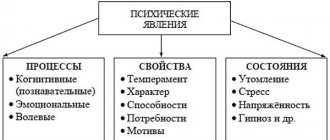It is worth noting right away that it is a mistake to use the words “communication” and “communication” as synonyms. Communication (according to Ozhegov’s explanatory dictionary) is mutual relations, business or friendly relations. This is an Old Church Slavonic word that has long been part of the Russian literary language.
“Communication” comes from the Latin word “communicare”. It means not only “to communicate”, but also “to do something in common; share something; act together, together." Both terms are united by the word “general,” and by this general is meant the subject of conversation. What's the difference?
Communication process and its role
The communication process is an exchange of information carried out between two or more individuals. Its purpose is to ensure the understanding and transmission of information that is the subject of exchange.
We transmit and receive information in order to:
- inform other people about something (for example, a press release or teletext);
- warn others (shouting or road signs);
- explain something (textbook);
- entertain (feature film or joke);
- convince someone (a poster calling for something);
- describe something (oral story or documentary).
These are the goals of communication. Most often, there are several of them within one process. For example, a film can inform, entertain, warn, describe, and explain.
Side
What does the communicative side of communication involve?
Communication is not just the movement of information, but a mutual exchange.
General meaning is developed when information is not only accepted, but also comprehended.
Accordingly, communication becomes possible when the source of information and its recipient have a similar encoding and decoding system . In other words, they must communicate in “the same language.”
Communication barriers often hinder the building of interaction. For example, an adult cannot explain to a two-year-old a question that is beyond the child’s understanding.
This is explained by the presence of an age barrier, due to which the subject and object of interaction have significantly different levels of intellectual development.
Also, a scientist will not be able to clearly convey information on a scientific issue to an athlete, since they have different levels of knowledge about the subject of discussion.
Satisfying human needs in the communication process
The main reason we all need communication is the social needs of the individual or group. A person enters into the process of communication in order to satisfy his immediate needs. Therefore, the above objectives of communication serve to satisfy basic human needs. Among them the following stand out:
- survival;
- personal needs;
- collaboration with others;
- maintaining relationships;
- persuading someone to think or act in a certain way;
- unification of organizations and societies into a single whole;
- exercising power over people (in particular, propaganda);
- manifestation of imagination and creative nature;
- awareness of the world around us and our experience in it (what we think about ourselves, what we believe, how we treat others, what is true).
Issues
Psychologists identify a number of problems that prevent people from building communication:
- Reluctance to feel the feelings of the interlocutor. If you don't take into account the other person's mood, it is impossible to establish effective communication.
- Lack of interest in the problem, inability to express true interest. Situations often occur when one of the interlocutors is interested in something and talks about it with enthusiasm and active gestures. The topic may be indifferent to another person, but according to the rule of etiquette, he must keep the conversation going.
- Lack of desire or ability to listen to the interlocutor. This problem interferes with productive communication. The inability to listen is manifested in constant interruption of the interlocutor, a sharp change of topic. A person who does not know how to listen to others often experiences serious problems in finding friends and moving up the career ladder.
- Closedness when communicating with others. This is the first barrier that appears when meeting someone. The problem actively develops with a negative attitude from others. A person begins to withdraw and finds it difficult to express feelings.
- High or low self-esteem. Only two people with approximately the same level of intelligence can communicate effectively. In this case, there will be no obstacles in understanding the interlocutor, common topics for conversation will appear.
For communication to be effective, you need to follow a number of rules:
- Learn to reject selfishness, think about the problems of your interlocutor.
- Every day learn to listen to others.
- Show interest in the topic of conversation.
When interacting with other people, you need to watch your words. It is unacceptable to insult the interlocutor, speak negatively about his point of view, or ridicule statements.
Encoder
An encoding device, or encoding, is a type of information transformation by a communicator. There is written and oral coding.
Oral means that the transmission of information is carried out through verbal or non-verbal methods (tone, facial expressions, and gestures often acquire much greater importance than ordinary words). An example of oral encoding is the translation of a message for deaf people. In this case, ordinary words are encoded with special signs that are transmitted to the addressee in a non-verbal way.
Written encoding is of the following types:
- electronic, when letters are converted into symbols (0 and 1);
- special when letters are converted into sounds (for example, Morse code).
Communicative communication in psychology - how information is exchanged
Communication allows people to exchange information with each other, share experiences and emotions. The individual must be ready to receive new data, since the effectiveness of communication will depend on this. Therefore, the conditions or information expressed by the partner cannot always be assimilated by the interlocutor correctly and fully. The possibility of losing the original meaning is allowed.
If both subjects are at too different levels of intellectual, emotional and spiritual development, then the information during their communication will be practically not absorbed. In some cases, this is also due to differences in value systems.
In communicative communication the following styles can be distinguished:
- Imperative. Authoritarian style, in which the subject has a significant influence on the object, which is in a subordinate state. Used in organizations with a strict hierarchy, such as the army.
- Ritual. Highly dependent on the cultural environment. Expressed in maintaining the customs of society. An example is the greeting phrase “How are you?”, to which it is customary to respond “Everything is fine.” Also included in the ritual style are apologies, congratulations, condolences, farewells, and hospitality.
- Manipulative. The goal of this style is to gain control over the subject. In this case, the influence is masked. In this case, personal motives become the main goal, and the exchange of information fades into the background.
- Humanistic. It is distinguished by equal rights for all parties, due to which effective perception of information can be achieved.
The communicative style of communication has the following features:
- correct speech, without an abundance of filler words;
- softness of tone;
- brevity, correctness and tact in relation to the interlocutor;
- absence of criticism, reproaches and accusations;
- unobtrusive compliments, praise.
In a conversation, both parties should demonstrate a desire to discuss positive topics and avoid all kinds of disputes, objections and interruptions of the interlocutor. In this way, good mutual understanding can be achieved, which will greatly facilitate the transfer of even very complex information.
If you devote enough time to developing your own speech, its thoughtfulness and logic, as well as the delicacy of presenting information, you can acquire enough skills for full-fledged communicative communication.
Channel and decoder
It is also necessary to consider such a concept as a channel. It is a means of transmitting information (meetings, written communications, oral communications, telephone conversations, reports, memos, computer networks, email, etc.).
A decoder (decoding) is a type of message transformation by the recipient. These are the same tools and methods that are used in encoding, only in this case they are used in the opposite direction.
History of the study and researchers
It is easier to understand the history of the study by the main researchers of communication if we consider the main models of information transfer between people:
- Socio-psychological - founder T. Newcomb.
- The linear model of communication was created by G. Lasswell.
- Noise model - founders K. Shannon, W. Weaver.
- The factor model was created by G. Malecki.
- Text model - founder A. Pyatigorsky.
In addition to these models, there are two well-known theories - communicative acts (creator T. M. Newcomb) and means of communication (founder Marshall McLuhan).
Communication functions
Since the time of Aristotle, thinkers have noted that the process of communication can manifest itself in different ways. Its essence depends on internal and external environmental conditions, declared and true goals of the parties, the number of participants, strategies and means of execution, etc. The functions of communication should be determined taking into account the influence of numerous factors on it. In the real process of transmitting messages, even in one communicative act, several functions are sometimes combined. Moreover, one or two of them are decisive, basic. We can also talk about the functions of this communication in general, that is, about what its role is in the life and activities of society and people.
As a rule, communication functions are isolated only for the purposes of applied scientific or research analysis. For example, this is necessary for consulting activities. An interaction model can be built by determining which functions are primary and which are secondary.
Types and functions of communication
Communicative interaction, along with external simplicity, is a complex multifaceted process that includes the establishment, formation and development of interpersonal contacts. Communication is the physical manifestation of the need of individuals for collective interaction. In the process of communication, there is an exchange of messages, perception and comprehension of the partner. Communicative interaction has its own individual structure, has its own goals, types and functions.
Psychology characterizes the levels, types, means and functions of communication from different aspects, which help to better understand the mechanism of communicative interaction. Without taking into account the characteristics of communication, it is very difficult to effectively interact with people. Types of communication and its functions are considered one of the core characteristics that make it possible to understand the very essence of interaction with another subject or society.
Types of communications are divided into formal, primitive, formal-role, business, interpersonal, manipulative and secular.
Formal communication involves the use of habitual behavior patterns (masks) during communication in order to hide one’s real emotions. With such communication, there is no desire to understand the partner.
Primitive communication implies mutual assessment by individuals of each other as an object capable of helping or, conversely, hindering. In such communication, the subject, having received what he wants, stops interaction.
Formal-role communication is built on the relationship between various social roles.
Business communication involves taking into account the characteristics of an individual’s personality and mood when communicating. This communication is always based on common business interests.
Interpersonal communication is based on deep understanding, perception and support by individuals of each other.
Manipulative communication is about acquiring benefits from communication. Secular communication is a non-objective interaction of subjects, in which they talk about what is necessary and accepted in society, and not their true thoughts.
The functions of communication are divided into intrapersonal, pragmatic, formation, development, confirmation, organization and maintenance, unification, separation and social functions. The intrapersonal communicative function involves the individual’s communication with himself. The pragmatic communicative function contains motivational reasons. The ability to influence partners contains a formative and developmental function. The function of confirmation is to enable individual knowledge and confirmation of oneself. The purpose of the functions of organizing and maintaining interpersonal interaction is to establish and maintain fruitful relationships. The function of combining and dissociating facilitates the translation of necessary data or differentiation.
Only by understanding the mechanisms of communication will an individual be able to differently evaluate this most important social tool that allows self-improvement and achieving goals. Social functions of communication represent the organization of joint activities, which covers management and control of behavior and activities.
Psychology considers the functions of communication to be the core properties that separate the manifestations of communication.
Communication models
To date, many communication models have accumulated in educational and specialized literature. Most of them were described by researchers in the 20th century. However, Aristotle proposed the first model known to us. Based on it, one can determine the tasks, functions of communication and its meaning. In his works “Rhetoric” and “Poetics”, the thinker presented the following model: “speaker-speech-listener”. He pointed out that this classical model is universal, as it fully reflects the act of communication in both written and oral forms.
However, in the first half of the 20th century, when mass media such as cinema, radio, and television began to develop, the classical model was slightly modified. In the 21st century, due to the development of computer technology, economic integration and political globalization, this model requires an even more in-depth interpretation. Once again, researchers are faced with the task of determining the main functions of mass communication.
Functions of communication according to Jacobson
According to Jacobson's model, the following six functions can be distinguished:
- expressive (emotive), associated with the addresser, expressing his attitude to the content of his speech;
- conative, reflecting orientation towards the addressee, expressing the impact on the interlocutor;
- referential (cognitive, denotative), context-oriented and a reference to the semantic object presented in the message;
- poetic (rhetorical), aimed mainly at communication, making a person’s everyday speech an example of verbal art;
- metalinguistic, which is associated with the code of the transmitted message, its understanding by the interlocutor, and correct interpretation;
- phatic, which is aimed at contact, at the continuous maintenance of this contact, and not at the novelty of the message or at its transmission.
The transfer of information affects a person’s actions and actions, his behavior, the state of his inner world and his organization. This is also indicated by some communication functions. The specificity of the process that interests us is that with its help the mental worlds of people interact with each other.
However, are only people capable of engaging in this process? As we noted above, the concept of communication can be viewed in several senses. Its functions described above are inherent in human communication. However, this does not mean that communication can only take place in the human world. We invite you to get acquainted with its diversity.
Communication barriers
- Phonetic barrier. It is due to the peculiarities of speech. It can be complete or incomplete. Incomplete misunderstanding occurs when a person slurs his words, has a lisp, or speaks very quickly. There can be a complete misunderstanding, for example, when conveying information in a foreign language. A phonetic barrier also occurs with a sharp increase in tone, since this blocks the understanding of what is being said, and attention is transferred to the attitude of the speaker. The phonetic barrier can be overcome by proper pause placement and moderately calm speech.
- Semantic barrier. It occurs when the interlocutor does not understand the meaning of what was said. This is due, for example, to the use of slang words by representatives of various subcultures. To overcome this barrier, it is necessary to abandon the use of speech forms used purely in your subculture.
- Stylistic barrier. This is a discrepancy between the style of data transmission and its content. For example, presenting a recipe in an artistic style.
- A logical barrier occurs in people with different types of thinking. For example, one interlocutor has abstract-logical, the other visual-figurative. You can explain the road in completely different ways. For a person with abstract logical thinking, it will look like this: “walk straight 200 meters to the pedestrian crossing sign, after it turn left and walk forward all the way until you meet a yellow sign.” For a person with visual-figurative thinking, the following explanation will be typical: “Go there (points forward with his hand) until you see a crowd of people, its direction will show you the further path.” It is necessary to learn to adapt to the type of thinking of the recipient of information.
Diversity of communication
So, this process is observed not only in human society. Communication is also characteristic of animals (the language of bees, capercaillie mating, mating dances of birds) and of mechanisms, that is, objects created by man (sewage, pipelines, telephone and telegraph signals, transport). Communications of a special kind can be observed even in inanimate nature. For example, it is carried out between some plants.
In particular, the African acacia, releasing special enzyme compounds into the surrounding space, informs other acacias about the invasion of a giraffe, which eats tree shoots. The leaves of trees that have received this information quickly acquire qualities that, from the animal’s point of view, are characteristic of inedible food. The process described above is characterized by the basic functions of communication and its characteristics. This means that it can be characterized by the term that interests us.
We briefly described the concept, role, and functions of communication. The material presented above reveals the main aspects of this topic.
Definition of the concept
What do we mean by the term "communication"? If we talk about this concept in simple language, it means communication in its various manifestations. And if this had not happened, it is impossible to imagine how a person would live.
The word “communication” comes to us from the Latin language. In it, communication means “transfer” or “message”. That is, communication in a general sense is understood as the exchange of information that occurs between interlocutors. It is also the transmission of a message from one person to another.
Types and forms of communication are very different, speech and non-speech. People, even without speaking, are able to communicate with each other using symbols, facial expressions or gestures. There is also written communication.
It becomes clear that if the transfer of information between several participants in a conversation turns out to be ineffective for some reason, then people will never be able to reach an agreement among themselves. In other words, various types of communications are the basis for the existence and activities of any organization.











